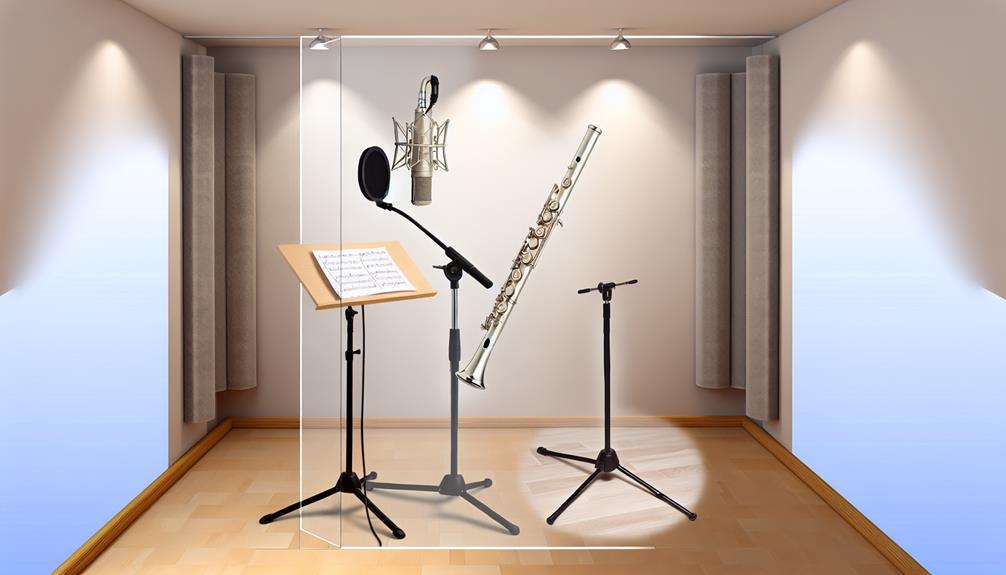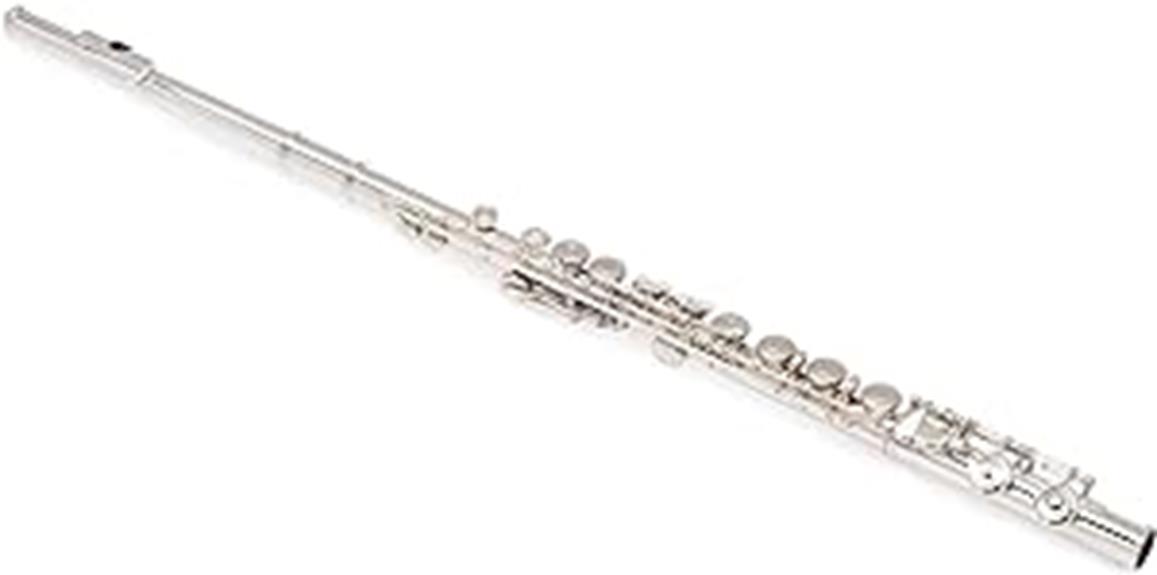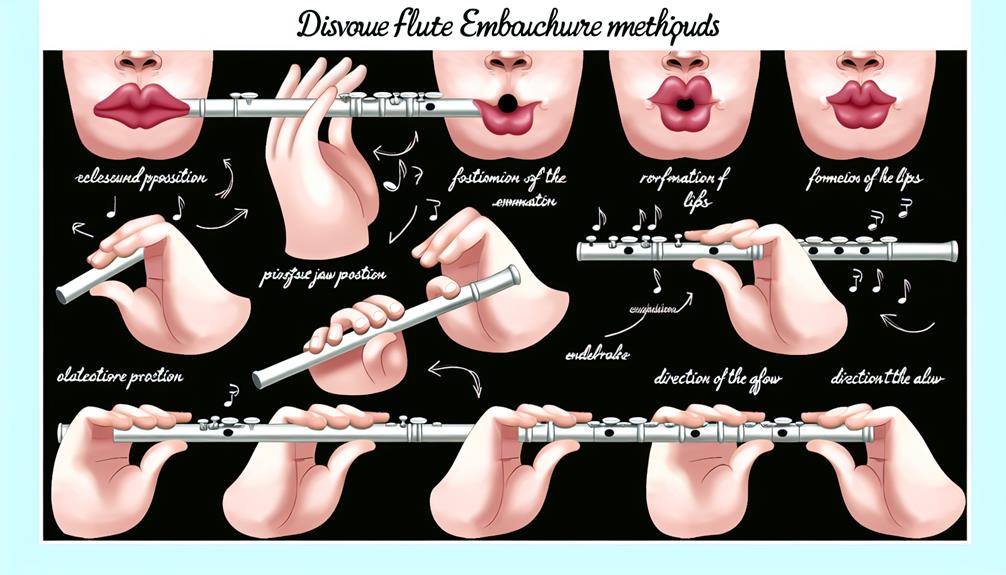As musicians, we understand the importance of safeguarding our instruments, especially the delicate nature of the flute. Whether it's the sweltering heat of summer or the bone-chilling cold of winter, knowing how to properly care for and store your flute during different seasons is key to maintaining its longevity and performance. By implementing specific strategies tailored to each season, you can ensure that your flute remains in optimal condition and continues to produce the beautiful music you cherish. Let's explore some expert tips and techniques for navigating the seasonal changes to keep your flute in prime playing shape.
Key Takeaways
- Monitor and control humidity levels between 40% to 60% using a hygrometer.
- Store flute in a cool, dry place away from direct sunlight during summer.
- Use a padded case with soft cloth in hot and humid months for protection.
- Shield flute from extreme temperature changes to prevent warping or cracking.
- Implement seasonal adjustments based on temperature and humidity variations.
Seasonal Climate Considerations
In considering seasonal climate impacts on flute maintenance, it is crucial to understand the potential effects of temperature and humidity variations. Fluctuations in temperature and humidity levels can significantly impact the condition of a flute. Extreme temperatures can cause the materials of the flute to expand or contract, affecting the instrument's overall structure and tuning. High humidity levels can lead to moisture buildup inside the instrument, potentially causing key sticking and pads to deteriorate. Conversely, low humidity levels can dry out the wood of the flute, leading to cracks or damage.
To mitigate these climate impacts, it is essential to practice proper seasonal maintenance. During the colder months, when indoor heating systems can reduce humidity levels, using a room humidifier can help maintain the necessary moisture levels for the flute. Additionally, storing the flute in a hard case when not in use can provide extra protection against temperature fluctuations. In contrast, during warmer months, storing the flute away from direct sunlight and in a cool, shaded area can help prevent the instrument from overheating and warping.
Understanding the climatic effects on flute maintenance is vital for ensuring the longevity and optimal performance of the instrument. By implementing these seasonal maintenance practices, flutists can safeguard their flutes against the adverse impacts of temperature and humidity variations.
Cleaning and Maintenance Tips
To ensure the longevity and optimal performance of a flute, meticulous cleaning and maintenance practices are essential. Proper care not only preserves the instrument but also ensures a clear and vibrant sound. Below are some cleaning techniques and a maintenance schedule to keep your flute in top condition:
| Cleaning Techniques | Frequency | Tools Needed |
|---|---|---|
| Wipe the flute body with a soft cloth | After each use | Soft cotton cloth |
| Clean the headjoint with a cleaning rod and cloth | Weekly | Cleaning rod, cloth |
| Use a silver polish cloth on keys (for silver-plated flutes) | Monthly | Silver polish cloth |
| Check for pad condition and tone holes cleanliness | Every 3-6 months | Pad cleaning paper, pad slick, key oil |
Maintenance Schedule:
- Daily: Wipe the flute body with a soft cloth after each use to remove moisture and fingerprints.
- Weekly: Clean the headjoint using a cleaning rod and cloth to remove any buildup.
- Monthly: Use a silver polish cloth on keys for silver-plated flutes to prevent tarnishing.
- Every 3-6 months: Check the pad condition and clean tone holes using appropriate tools to maintain optimal performance.
Storage Recommendations by Season
For optimal preservation of your flute's integrity and performance, it is imperative to adhere to proper storage practices tailored to different seasons. Proper insulation is key to maintaining the condition of your flute throughout the year. During the hot and humid summer months, store your flute in a cool and dry place away from direct sunlight to prevent damage to the pads and key mechanisms. Consider using a padded case with a soft cloth to protect the flute from excessive heat and moisture.
In contrast, during the cold winter months, it is essential to shield your flute from extreme temperature changes. Sudden shifts in temperature can cause the materials of the flute to expand or contract, potentially leading to damage. To prevent this, avoid placing your flute near heaters or air conditioning units. Instead, store it in a room with stable temperature levels and moderate humidity. When not in use, keep the flute in its case to provide an additional layer of insulation.
Make seasonal adjustments to your storage location based on the temperature and humidity levels to ensure your flute remains in optimal condition. By following these storage recommendations by season, you can prolong the life of your flute and maintain its quality performance.
Preventing Damage From Temperature Changes
How can temperature changes impact the structural integrity of your flute, and what measures can be taken to prevent potential damage? Fluctuations in temperature can have a significant impact on your flute, potentially leading to issues such as warping, cracking, or changes in tuning. To prevent damage, it is essential to implement preventive measures and maintain proper temperature control when storing your instrument.
Preventive Measures for Temperature Control:
| Preventive Measure | Description |
|---|---|
| Store in a consistent environment | Fluctuations in temperature can stress the wood or metal of the flute. Store your flute in a consistent environment to prevent sudden changes. |
| Use a quality case | A well-padded case provides insulation against extreme temperatures. Choose a case that offers protection and temperature regulation. |
| Avoid direct sunlight | Sunlight can heat up your flute rapidly, causing damage. Store your flute away from direct sunlight to prevent overheating. |
| Allow acclimatization time | When moving your flute between temperature extremes, allow it time to acclimate before playing. This prevents sudden changes that could harm the instrument. |
Humidity Control for Flute Care
Maintaining optimal humidity levels is crucial for preserving the quality and longevity of your flute. Fluctuations in humidity can lead to issues such as warping, cracking, or damage to the pads and key mechanisms. To ensure proper humidity control and instrument protection, consider the following tips:
- Use a Hygrometer: Invest in a hygrometer to monitor the humidity levels where you store your flute accurately.
- Ideal Humidity Range: Aim to keep the humidity levels between 40% to 60% to maintain the integrity of the wood and prevent damage.
- Humidifier or Dehumidifier: Depending on the climate, use a humidifier to add moisture or a dehumidifier to reduce moisture in the air.
- Storage Considerations: Store your flute in a hard case with a soft inner lining to protect it from extreme humidity changes.
- Swab Your Flute: After playing, swab out the moisture from inside the flute to prevent water buildup that can be harmful.
Special Care Tips for Extreme Conditions
Given the sensitivity of flutes to environmental conditions, particularly humidity, it is imperative to adopt specialized care strategies when faced with extreme weather circumstances. In extreme cold conditions, such as during winter, it is crucial to protect your flute from sudden temperature changes. Fluctuations in temperature can cause the metal in the instrument to contract or expand rapidly, potentially leading to damage. To mitigate this risk, always allow your flute to acclimate gradually to room temperature before playing it. Additionally, consider using a protective case with thermal insulation to shield the flute from extreme cold when transporting it.
Conversely, in extremely hot conditions, such as during summer, the risk lies in the expansion of materials. High temperatures can cause the keys and mechanisms of the flute to swell, impacting their movement and potentially affecting the instrument's playability. To safeguard against this, store your flute in a cool, dry place away from direct sunlight when not in use. Using an instrument cover made of breathable material can also help regulate the temperature around the flute and prevent overheating.
Frequently Asked Questions
Can I Use the Same Cleaning Products for Both Silver and Gold Flutes?
When cleaning a flute, it is essential to use appropriate products to maintain its longevity. For silver and gold flutes, it is recommended to use separate cleaning products specifically designed for each metal type.
Silver and gold have different properties that require tailored care to prevent damage. By using the correct cleaning methods and products, you can ensure the maintenance and care of your flute, prolonging its lifespan and preserving its quality.
Is It Safe to Store My Flute in a Fabric-Lined Case?
Storing a flute in a fabric-lined case can provide adequate protection, but careful consideration must be given to moisture control. Fabric can absorb moisture, potentially leading to damage if humidity levels are not controlled.
It is advisable to use protective materials such as desiccants or moisture-absorbing pouches within the case to mitigate this risk. Regularly inspecting the case and fabric for any signs of moisture buildup is essential for maintaining the flute's condition.
Can I Leave My Flute in a Hot Car for a Short Period?
Leaving your flute in a hot car, even for a short period, is not recommended. Extreme temperatures, especially in the summer heat, can damage the delicate mechanisms and materials of the instrument.
Flute maintenance is crucial for preserving its quality and performance. To ensure the longevity of your flute, it is best to avoid exposing it to such conditions and instead store it in a cool, dry place to maintain its optimal condition.
Should I Oil My Flute's Keys During the Winter Months?
During the winter months, it is advisable to oil your flute's keys to prevent rust and ensure proper key maintenance.
Winter weather conditions can lead to increased moisture levels, which may contribute to the corrosion of metal keys.
By regularly oiling the keys, you can protect them from potential damage caused by humidity and cold temperatures.
This simple maintenance practice can help preserve the longevity and performance of your instrument.
Can I Use a Hairdryer to Quickly Dry My Flute After Cleaning?
Using a hairdryer to quickly dry your flute after cleaning is not recommended. The intense heat generated by a hairdryer can potentially damage the delicate mechanisms and materials of the flute.
Flute maintenance should prioritize gentle and careful drying techniques to prevent any harm to the instrument. Heat damage can compromise the functionality and longevity of your flute, so it is advisable to avoid using a hairdryer for this purpose and opt for safer drying methods.
Conclusion
In conclusion, proper maintenance and storage of your flute throughout the changing seasons is essential for preserving its quality and performance. By following the tips outlined in this article, you can ensure that your flute remains in optimal condition regardless of the climate.
Remember to adjust your care routine based on temperature and humidity levels to prevent damage and prolong the lifespan of your instrument. Take care of your flute, and it will reward you with beautiful music for years to come.





